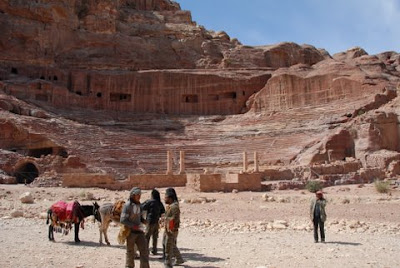Petra was established about 100 BC and grew quickly. The industrious people carved nearly 3,000 monuments and tombs into the red cliffs that surrounded their city. In 106 AD, the Roman Emperor Trajan laid claim to the area, though daily life in the city changed little. Christianity was introduced in Petra about 350 AD and flourished briefly. However, in 363 AD a huge earthquake destroyed half the city and a long decline began. Trade routes changed and business fell. By 700 AD the area was home to only tiny populace and became "lost" to the outside world until "discovered" by a British explorer in 1812.
Made famous in the movie "Indiana Jones and the Last Crusade," Petra today is a popular tourist attraction. Although Israel and Jordan both maintain strict security controls on their borders, it is well worth the hassle to visit this beautiful and mysterious relic of the past.

We arrived late in the evening at this picturesque hotel.

Despite the austere exterior, the rooms were charming and comfortable.

The next morning we awoke to this view of the surrounding desert.

The entrance to Petra begins with a 1 1/2 mile walk through the Siq, a narrow gorge carved in the rock by wind and rain.

The entrance to the Siq reminded many of us of the slot canyons in Utah.

The Siq continues to get deeper...

and deeper...

and deeper as we proceeded.

Then suddenly, the gorge opens up to reveal...

an eye-popping view of Al Khazneh, "The Treasury."

The Treasury, misidentified by Indiana Jones as the hiding place of the Holy Grail, is actually an ancient royal tomb.

We continue down the Siq into the main part of the city.

The colonnaded street only hints at the bustle of commerce that once existed in this area.

A local bedouin provides a glimpse of the past.

Huge tombs line the walls of the valley that surround the city,

though many of the tombs are more down-to-earth.

The amphitheater marks the center of the old city.

Continuing down the main avenue, we encounter travelers on camel. Note the camel-shaped rock formation on the horizon.

We come upon more camels which are there to provide a lift to the footsore tourist.

We decline the lift and head further into the canyon. These steps, carved by the original inhabitants...

and this precipitous trail...

eventually lead to another stunning tomb; El Deir, "The Monastery." We pause to wonder at the industry and craft required to carve these huge works from solid rock.

Just past The Monastery we arrive at the end of the trail, this overlook of the forbidding mountains, and beyond, the Jordanian desert. Not a very hospitable landscape and a good reason to turn around and head back.

4 comments:
Great shots. I recognize some of them from 99. I did not know that there was a jewel from long ago. Dad
Nice write up. I think you learned more there than I did.
Incredible! I love this blog! ;) We miss you and wanted to be at our mission reunion so much, but Stan had a previous Brasil missionary assignment on the same night. Next year for sure!
You have such a gift for photography and art. Thank you for sharing it. Give each other a big hug from us, Brenda (and Stan) Benedict
Blaine and carrie
Thanks for leaving the trip on our
computer. Feels like we wear a part of it.
Post a Comment